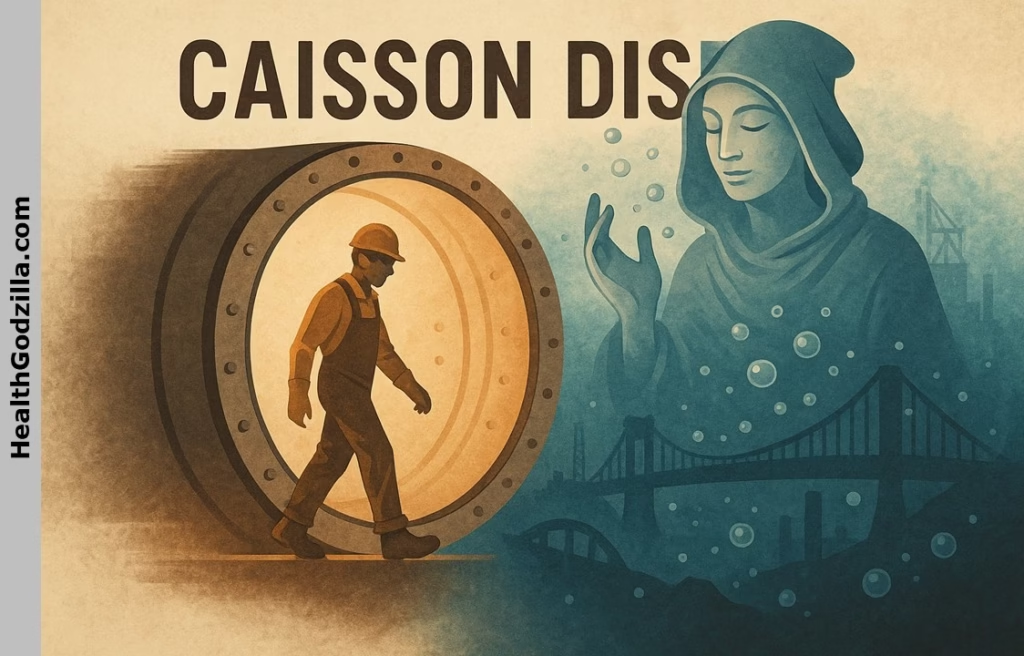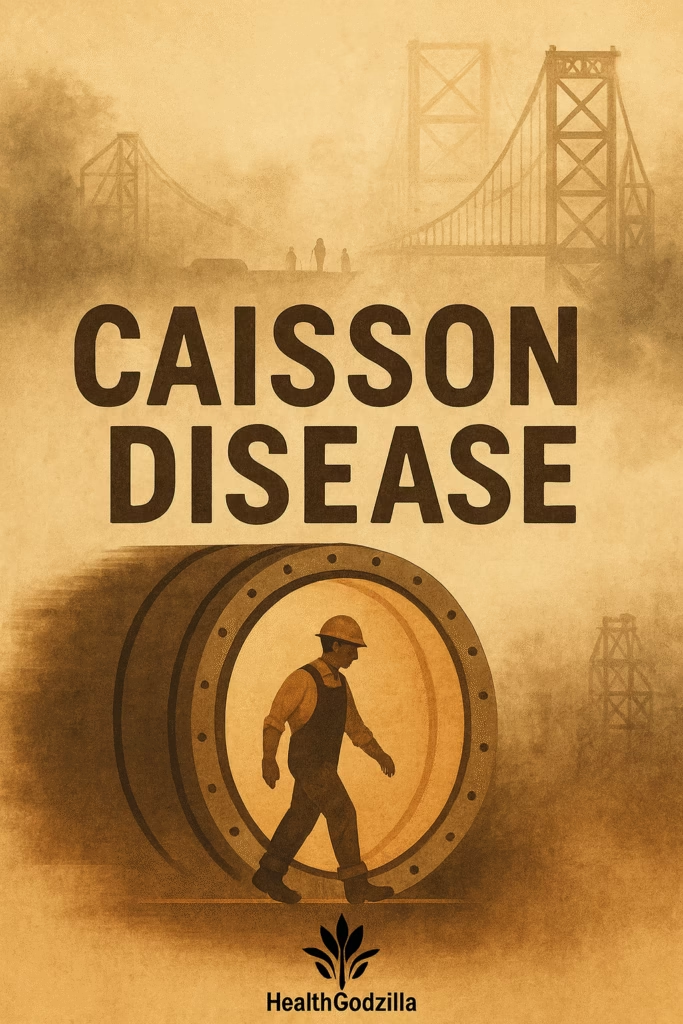
Prologue — The Breath in the Box
The caisson lies buried half in earth, half in water—an iron lung of industry. Its walls throb with the hiss of air forced inward, pushing back rivers and mud so that men may dig foundations for bridges that touch the sky. Yet within this chamber lives the ghost we call Caisson Disease, born of pressure and invisible bubbles. In this half-lit space, where the ground quivers and the breath feels heavier than stone, Kimiya appears.
⚗️ They are not seen as a figure, but felt—a shimmer in the lamplight, a curl of vapor curling above the waterlogged soil. They move between workers bent at their spines, their bodies taut as bowstrings against the unseen pressure. Kimiya whispers into the air that presses into flesh and bone: “Air is not innocent. Even breath has weight, and bubbles can betray.”
It is here, in the caisson, that caisson disease first spoke its name—though at the time it was only groans, bent joints, and men clutching their chests. Workers staggered out of the airlock as though cursed by invisible hands, their limbs twisted in pain, their lungs burning. Bridges were built, yes—but also graves were dug.
The enemy was not in sight. No flame, no claw, no strike of hammer. The danger was air itself: compressed, then loosed too quickly. Invisible nitrogen, faithful companion of our atmosphere, turned traitor when bubbles swelled in blood and bone. Joints bent until men could not straighten. Lungs filled with coughs that rattled like gravel. Some were left paralyzed, some gasped their last.
And Kimiya watched. Not with judgment, but with the weight of memory. They drifted beside the workers as bubbles formed like cruel stars inside human flesh. Kimiya traced the arc of every spine that bent, every chest that shuddered, every bridge that rose on the suffering of bodies.
The breath in the box—that is where our story begins. Not with triumph, but with a warning: air can build, air can break.
Act I — The Invisible Enemy (Science of Pressure and Bubbles)
Air, to most, is nothing—an emptiness to be breathed without thought. But to Kimiya, the Whispering Alchemist, air is a restless library, each molecule a word written in laws older than fire. They drift their hand across unseen equations, and the chamber stirs—the hidden script of Caisson Disease already forming in silence.
Boyle’s law speaks first, its voice firm and mathematical: “Volume shrinks as pressure grows; volume expands when pressure falls.” A lung at depth holds not breath, but dynamite—if the diver ascends too quickly, the air trapped inside will swell like a storm and rupture flesh from within.
Then Henry’s law hums its secret: “What pressure presses down, the body drinks in.” At depth, nitrogen seeps quietly into blood and tissue, dissolving in fat and nerve, waiting like a sleeper beneath the skin. Kimiya whispers beside it: “The body is a vessel of hidden gases; release them too quickly, and they riot.”
And riot they do.
- In the nervous system, bubbles crowd the white matter, twisting signals into paralysis, convulsions, and stuttering tongues.
- In the joints, they knot themselves into fiery beads, bending spines and knees until workers stagger like broken marionettes—the dreaded bends.
- In the lungs, they erupt as coughs and choking, drowning a man in air itself—the chokes.
- On the skin, they rise as tiny storms, itches and marbling rash—the diver’s itches, cutis marmorata, the map of danger traced across flesh.
To those who cannot see them, these bubbles are nothing. Yet they are tyrants in miniature—crowds of nitrogen drunk on sudden freedom, breaking vessels, robbing breath, twisting joints. This is the hidden anatomy of Caisson Disease, the silent rebellion of air against flesh.
Kimiya drifts closer, not to condemn, but to remind: “The enemy is invisible, but the scars are not. What bends the body bends the bridge, the mine, the ship. Learn to breathe by law, or lawless bubbles will claim you.”
Thus the science of pressure is no abstraction here—it is the scripture of survival. Every breath is a covenant with physics, every ascent a negotiation with the unseen.
Act II — Tunnels, Bridges, and Bends (History)
The first whispers rose not from oceans, but from the dark belly of the earth. Charles-Jean Triger, a French engineer, lowered his caisson into the Loire Valley in 1840. Air was pumped in to push the water away so coal could be mined beneath the riverbed. Men descended through airlocks into the pressurized chamber, shoulders taut, lungs strained. When they returned to the surface, some staggered with joint pain, breathlessness, and strange fevers. Triger called it mal de caisson—what we now know as Caisson Disease. He prescribed alcohol, and the men returned to work.
⚗️ Kimiya was there, shimmering in the damp light, curling around Triger’s chamber. They whispered to the coal-stained workers: “This box carries both wealth and wounds. Your bones are ledger books written in bubbles.”
The disease spread beyond France. In the summer of 1868, at the St. Louis Bridge across the Mississippi, the caissons pressed deeper into the earth. At depths of 60 to 93 feet, men emerged bent over in pain, their bodies folded like the fashionable Grecian Bend. Joints stiffened, lungs rattled, paralysis crept up legs. Nearly a quarter of the workers fell ill; thirteen died.
On a barge nearby, Dr. Alphonse Jaminet set up an improvised infirmary—the first American occupational clinic. He watched men stumble from the caissons, offered blankets and beef tea, and recorded their cries. He himself was stricken, paralyzed for days, yet kept notes even from his cot. Kimiya drifted through the infirmary, tracing frost on glass and sweat on brows, whispering: “The body is the first bridge; when it breaks, no span can stand.”
Then came the Brooklyn Bridge. The caissons here were vast—iron cathedrals sunk into mud. Washington Roebling, chief engineer, descended to inspect his workers’ world and rose again—struck by paralysis that never left, his body marked by the weight of the depths. The physician Andrew H. Smith observed 86 cases, noting headaches, paralysis, pruritus, and vomiting. In 1873, he named the affliction caisson disease, giving shape to the ghost.
And still Kimiya lingered, in the sweat, in the gaslight, in the pounding hearts of men who built the foundations of a city while their own foundations cracked.
The science sharpened. Paul Bert, the French physiologist, proved it was not curses or congestion, but nitrogen bubbles, invisible assassins born from rapid decompression. He proposed what remains true 150 years later: slow ascent, oxygen, recompression. He turned whispers into words.
Later, John Scott Haldane refined the survival script. He introduced staged decompression, measured in tissue “half-times.”
Through charts and numbers, he mapped the mathematics of breath, building decompression tables that transformed chaos into order.
Kimiya watched as he confirmed what they already knew: fat-laden tissues hold more nitrogen, and bubbles bloom where blood is slow.
Haldane whispered rules into the ears of navies and miners, laying the blueprint of safety still in use today.
⚗️ Kimiya drifts between these names and bridges, between blood and law, and murmurs: “Each span of steel was paid for with bones. Each tunnel carved, with marrow. Yet from the wounds came science, from the cripples came caution. Bubbles broke bodies, but also birthed knowledge.”
Thus history bent with the bodies, until air itself was forced to confess its dangers.

Act III — The Workplace Body (ILO & Modern Medicine)
The caisson may belong to the past, but the body still carries its memory. Wherever pressure bends air—beneath oceans, within tunnels, inside hyperbaric chambers, or above in thin skies—the same ghosts return.
Divers breathe the sea’s weight.
Caisson workers burrow foundations for cities.
Tunnel diggers push through rock while air pushes back.
Chamber operators tend patients in pressurized rooms.
Aviators rise into cabins where air thins like a dying flame.
All are apprentices of pressure, though not all know it.
⚗️ Kimiya drifts among them, counting risks like beads on a rosary: ear clogged with pain, sinuses cracking under trapped air, lungs swelling with a cough that bursts into hemorrhage. This is barotrauma—the body imploding or exploding by Boyle’s ancient law. A rupture in the chest, a sudden gasp, and bubbles race into arteries, stealing breath from the brain. The bureaucrats give it a code: T70.0, T70.1, T70.2, T79.0. But workers know it as collapse, dizziness, ringing ears, blood on lips.
Then comes decompression sickness, the infamous bends. Influenza-like aches, back pain, paralysis, mottled skin, the “chokes” that drown in invisible water. It arrives within minutes, sometimes hours, but always with the certainty of betrayal. The International Labour Office lists it as T70.3, a neat alphanumeric brand for an untidy agony.
For some, the curse lingers. Dysbaric osteonecrosis eats bones in silence, months or years after the pressure has passed. The hip crumbles, the shoulder cracks, the knee caves. A man once strong becomes a man of shadows, disabled by bubbles fossilized into his marrow. Medicine calls it M90.3 + T70.3; the worker calls it the end of work.
⚗️ Kimiya bends close, whispering: “The body is law, and the law must listen. Every code is a scar turned into text, every chart a confession.”
Modern medicine fights back. Oxygen masks strapped tight to purge nitrogen. Recompression chambers to force bubbles back into silence. Intravenous fluids, CPR, stretchers carried to aircraft that must themselves be pressurized to avoid new injury. Here urgency matters: minutes are the thin line between healing and death.
Prevention is written in numbers: decompression tables, dive computers, safety stops at shallow depths, limits on pressure and time. Health surveillance by occupational physicians, pre-placement checks for fitness, denitrogenation before flight. The worker’s breath becomes a script, read and reread, so physics does not ambush them again.
And still, accidents occur. A valve fails, a diver rushes, a pilot forgets the wait. Even now, decompression sickness haunts, less often fatal, but still cruel.
Act IV — Safety, Law, and Shadows
For centuries, men learned the cost of pressure through broken bodies. But law, slow as stone, began to listen. Out of caisson infirmaries and bridge tragedies grew a framework—not perfect, but a shield hammered from collapse.
The International Labour Office (ILO) carved the first statutes into the air:
- Workers in hyperbaric or hypobaric conditions must undergo pre-placement fitness checks—their lungs, joints, and hearts tested like scaffolds before a climb.
- Exposure limits: 0.7 bar for no more than eight hours; at least 12 consecutive hours spent at surface level each day.
- Denitrogenation protocols: before flight, breathe pure oxygen to purge the silent betrayer.
- Health surveillance: not a luxury, but a duty—early signs caught before they calcify into osteonecrosis or collapse.
⚗️ Kimiya whispers through the clauses, not mocking but reminding: “The law is written in lungs, not in ledgers. Each statute is an echo of pain already paid.”
Technology brought hope. Remote-controlled tools now tunnel where men once bent. Smart systems adjust pressure automatically. Hyperbaric chambers stand ready on ships, in hospitals, even deployable by air. Automation reduces risk—machines taking the blows once borne by flesh.
And yet, in the informal sectors, shadows remain. In coastal villages, pearl divers plunge without tables or chambers. Fishermen and aquaculture workers breathe through makeshift hoses, unaware that nitrogen waits in their blood. Small repair crews slip beneath piers and barges with borrowed gear, their lungs collateral for wages. No law shields them, no chamber rescues them. Here, Caisson Disease still claims the unwary, not in bridges or tunnels, but in nets and docks.
Kimiya lingers especially here—in the shimmer of a bubble net cast for fish, in the cough of a diver who surfaces too quickly. They whisper, “Workers should not pay with bones for the bridges of the world.”
Workplace safety laws are not gifts. They are shields that workers and history forged from centuries of collapse, annealed them in sweat, and hammered them in the cries of the bent and broken. Each article, each guideline, each ICD code carries the scars of lives that already surrendered.
The shadows remind us: progress without caution is a debt. And debts written in marrow can never truly be repaid.
Epilogue — The Whisper in the Chamber
The caisson door shuts, and the hiss of air fades. Kimiya lingers in the silence, neither form nor shadow, only a shimmer of memory. They have walked with us through tunnels, beneath rivers, along scaffolds, and into chambers where breath grows heavy. They have seen bones bent like arches and lungs ruptured like thin glass.
⚗️ Yet they whisper still: “The story of air is the story of humanity—breath pressed, stretched, and freed.”
Air has always been double-faced. It carries both promise and peril: the invisible hand that sustains life, and the invisible blade that severs it when people break the rules. From the depths of Triger’s coal caissons to the shimmer of pearl divers’ bubbles, from submarines beneath pressure to aircraft in thinning skies, Caisson Disease still whispers—a ghost that refuses memory’s silence.
Kimiya drifts at the threshold, leaving no warning, only remembrance: “Rigid things crack, but roots learn to weave around stone.”
And so, as science bends toward law, and law bends toward mercy, the whispers remain—an echo of bubbles, of bridges, of survival.
The chamber door opens, and another voice enters. It is time for Hello, Artista.
🍂 Hello, Artista

Artista leaned back in her chair in Vancouver, her two rabbits, Whitee and Brownie, tumbling near her feet. She laughed softly and said,
“Sometimes I imagine them floating in invisible bubbles, like astronauts—ears twitching, paws paddling in the air. It’s funny… but also a little frightening. What if those bubbles were not play, but peril?”
Organum, writing from Boston with his dogs dozing at his side, paused before answering.
“I’ve seen bubbles that did not sparkle,” he said. “Workers bent over by unseen forces, joints stiffened as though their bones had been welded crooked. I think of caisson men, divers, even pilots—victims of air itself. Not drowning in water, not burning in fire, but buckled by breath.”
Artista’s smile softened. “So fragile we are—breath alone can break us. Yet here we are, alive because of it.”
Organum nodded. “That’s the paradox of safety. Fragility is always near, but so is resilience. With care, with law, with knowledge, breath becomes shield instead of snare. But when we forget—when we grow careless—Caisson Disease writes its warnings in marrow.”
Artista lifted Whitee in her arms, the rabbit’s whiskers brushing her cheek.
“Then maybe,” she whispered, “safety is not about walls or cages, but about remembering. Every breath is a thread. Hold it gently, or it snaps.”
And in that moment, as if carried on the current of their words, a faint shimmer passed the room—Kimiya, drifting unseen, leaving only the echo of caution in the air.
✍️ Author’s Reflection
I was not alone when I wrote this. Others spoke, and I listened.
The caisson men, the divers, the aviators, the physicians—they whispered through archives and through scars. Kimiya walked beside them, leaving no orders, only signs.
The story of caisson disease is not only a ledger of suffering, but a mirror of how humanity learns. Each bubble in the blood became a sentence in science.
A bent body turned into a paragraph in law.
Every collapse forced a bridge between peril and protection.
When I look back, I see not only tunnels and rivers, but also laboratories, hospitals, and classrooms—all connected by breath. Workers who coughed in darkness unknowingly built the decompression tables that save divers today. Bridges still stand because spines once bent. Laws protect because bones once cracked.
And yet, the panorama remains unfinished. In the shimmer of pearl divers, in the quiet of informal laborers, in the thin air above 8,000 feet, the whispers continue.
Kimiya drifts there still, neither judge nor savior, but a breeze with the fragrance of jasmine—a chest full of ease-breath, reminding us:
Every breath is a covenant. Hold it gently, or it will snap.
The curtain falls. Yet in falling, it opens a new horizon where safety, history, and survival breathe together.
🌼 Articles You May Like
From metal minds to stardust thoughts—more journeys await:
- Groupthink and Leadership: Born or Made in the Mindset Mirror
Groupthink and leadership—twin forces shaped by mindset. Discover how silence, dissent, and growth define whether leaders are born or made. - Platinum Exposure Health Risks: A Tale of Beauty and Peril
The fragile balance between progress and protection—platinum’s brilliance hides unseen costs for workers and communities. - Eco-Nutrition: Systems Diversity and Sustainable Diets
Eco-nutrition links biodiversity, food systems diversity, and sustainable diets—woven together for a resilient, healthier future.
Curated with stardust by Organum & Artista, under a sky full of questions.
📚 Principal Sources
- Niu, S., Colosio, C., Carugno, M., & Adisesh, A. (Eds.). (2022). Diagnostic and exposure criteria for occupational diseases: Guidance notes for diagnosis and prevention of the diseases in the ILO list of occupational diseases (Revised 2010). International Labour Office. https://www.ilo.org/publications/diagnostic-and-exposure-criteria-occupational-diseases-guidance-notes-0
- Moon, R. E. (2025). Decompression sickness (caisson disease; the bends). In D. M. Birnbaumer (Ed.), MSD Manual Professional Edition. Duke University Medical Center; David Geffen School of Medicine at UCLA. https://www.msdmanuals.com/professional/injuries-poisoning/injury-during-diving-or-work-in-compressed-air/decompression-sickness
- Ninokawa, S., & Nordham, K. (2022). Discovery of caisson disease: A dive into the history of decompression sickness. Journal of Anesthesia History, 8(1), 1–7. National Library of Medicine. https://pmc.ncbi.nlm.nih.gov/articles/PMC8682815/
- The Editors of Encyclopaedia Britannica. (2025, September 9). Decompression sickness. In Encyclopaedia Britannica. https://www.britannica.com/science/decompression-sickness
Relevant chapters and sections were interpreted through a narrative lens rather than cited academically.
This article is also archived for open access on Zenodo: https://doi.org/10.5281/zenodo.17181957. Archiving ensures its permanence in the scholarly record.

Leave a Reply